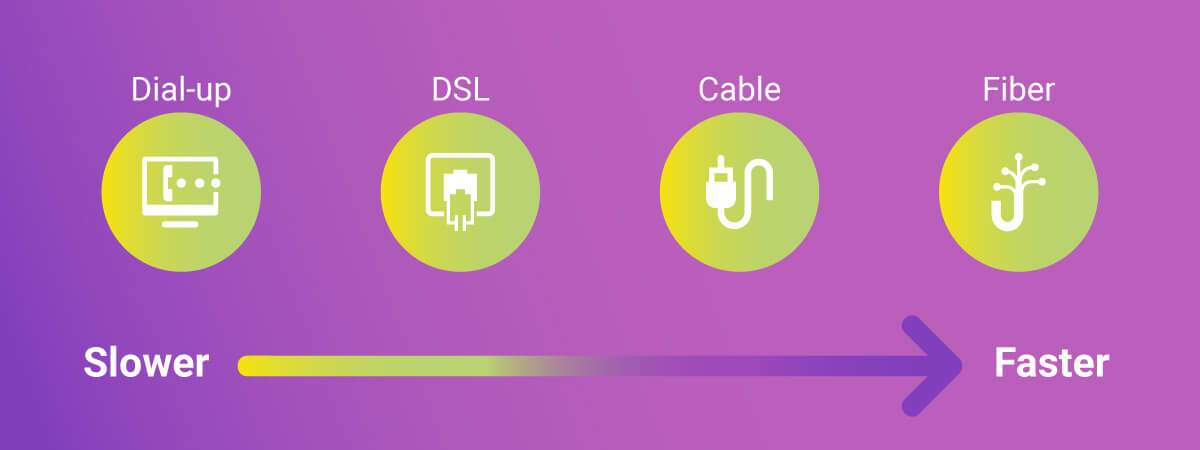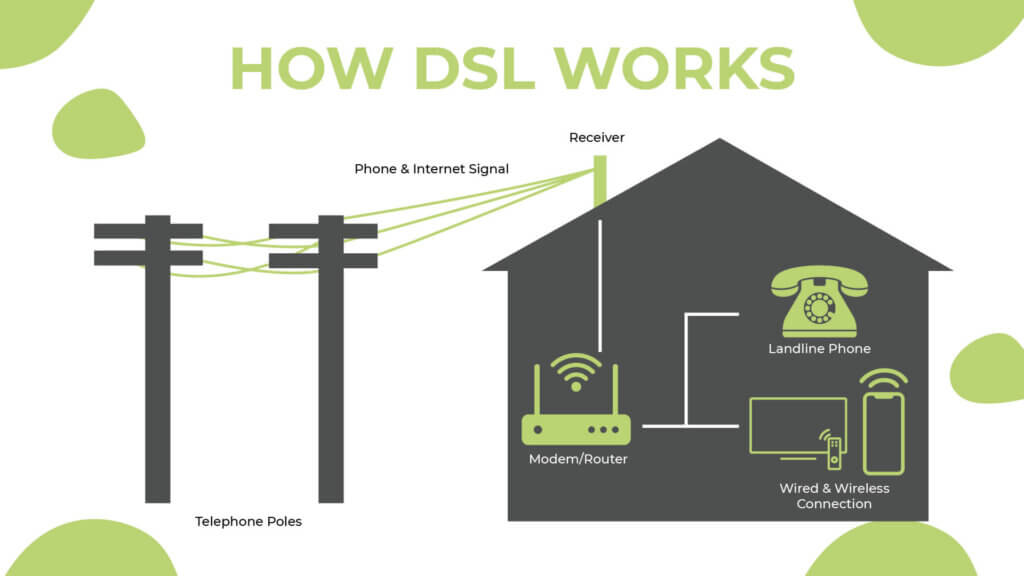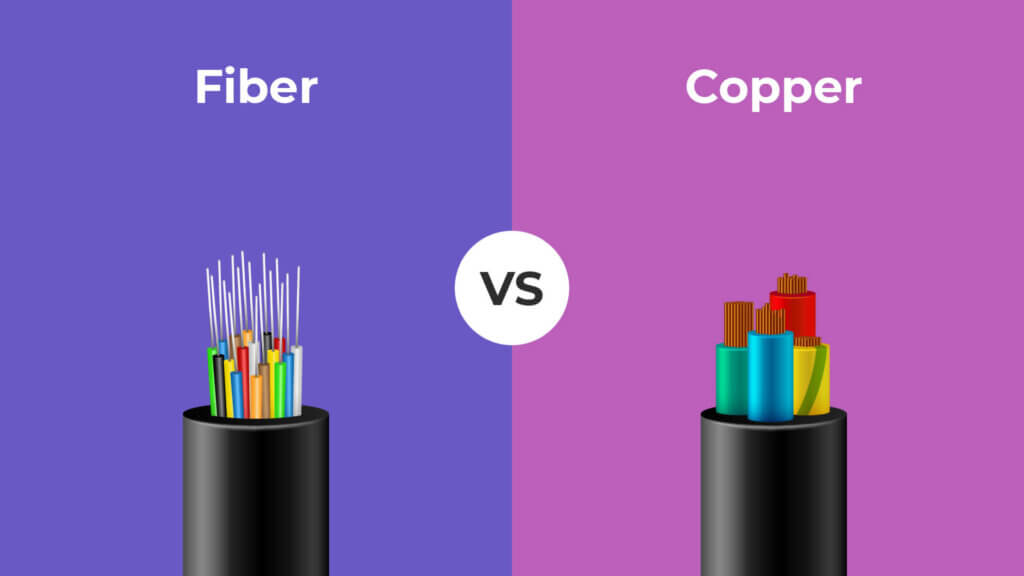Lower your internet bill
61% of people overpay for their internet.
Are you one of them?
Unlock exclusive offers in your area!
Call now
[tel]Enter zip code
1 Star is Poor & 5 Stars is Excellent.
* Required

Written by Rosslyn Elliott - Pub. Mar 14, 2022 / Updated Oct 23, 2025
Table of Contents
Are you happy with your Internet service?

About the author
Rowboat vs speedboat? That’s your choice with DSL vs fiber internet. Take a quick ride with us through the pros and cons of DSL and fiber so you know what to expect.
DSL is the rowboat of internet types. It’s very common, and you can often find DSL in urban and small-town settings. If you move into a different home, DSL service may be waiting for you like a rowboat pulled up on a bank. Just be aware that in this rowboat, your speed will be very slow as you navigate the internet.
In a speedboat, you can whoosh to your destination at least 50 times faster than in the rowboat. That speedboat is fiber internet — the speediest of internet connections.
But you may not find a fiber speedboat just pulled up and waiting for you at your new home. Speedboats are new, valuable, and not nearly as common as rowboats. So, the tough news is that you may not be able to jump on this fiber internet speedboat just yet.
You may not have fiber infrastructure where you live. Fewer than half of the households in the United States have fiber access. If your only wired option is DSL, this article will explain what to expect from your internet performance.
Sometimes, you may find you have a choice between DSL and fiber from internet service providers in your area. If you’re in that lucky position, you will need to know why the difference between DSL and fiber internet could be important to your future.

Most of the internet works like a data river flowing across continents. The main flow of data on the internet is carried by fiber-optic lines. So, most of the internet that travels over long distances is already based on fiber internet connections. (This part of the internet is usually called the internet backbone. And when it runs under oceans, the fiber-optic lines run underwater for thousands of miles as submarine cables. Super-cool!)
But fiber-optic lines often don’t run all the way to your home. In the last miles that data travels from your ISP’s major lines to your home, the wires frequently switch over to a different kind of technology, usually either DSL or cable. Both of these internet types are carried through copper wiring instead of the glass lines that carry fiber.
Electrical signals pulse through copper much more slowly than light signals flash through glass. That’s why copper-based types of internet are slower than fiber.
DSL stands for Digital Subscriber Line. DSL transmits data through a telephone line that gives you internet access.
DSL providers bring internet to many areas that don’t have any other wired internet infrastructure.
DSL is able to reach so many households because telephone cables were installed all over the nation in the twentieth century. Before cell phones, landlines were the only way to communicate instantly over long distances. People had a powerful incentive to get phone lines run into every home in America.
Present-day DSL connectivity continues to rely on telephone wires as a way to provide internet service.
For DSL services to work, you need a modem and two copper wires paired within a phone line. Without those two components, a DSL service won’t be able to receive or transmit data.
DSL speeds vary, but DSL will always be much slower than fiber internet.
DSL upload speeds range from one to 10 Mbps, while download speeds range from five to 40 Mbps. (Only occasionally does DSL make it up to 100 Mbps download speed, with newer DSL technologies called IPBB).
DSL internet speeds are too slow to perform well for online activities such as multi-player gaming or HD streaming.
| Pros of DSL | Cons of DSL |
| Wide availability | Slow speed |
| Easy installation | High prices when measured by dollar per Mbps |
| No annual contracts on many plans | Not available in remote areas |
| Faster than dial-up internet and some satellite internet | Can’t support gaming or HD streaming |
If your only choice for wired internet is DSL, here are some pros of DSL internet.
DSL has one major advantage that explains why it still serves so many customers: availability.
DSL travels through telephone lines, and those lines reach many parts of the United States. For many people, DSL is their only wired alternative to satellite internet or dial-up internet.
DSL will in some cases give you a faster and more stable connection than satellite internet. DSL will always give you a better connection than dial-up internet.
DSL has brought reliable internet to millions of people for many years, and DSL can still bring you good support for standard internet functions such as email and web browsing.
Unlike cable internet, a DSL connection doesn’t share connectivity with other neighborhood users. Cable internet speeds may sometimes be influenced by the number of users in an area who are online at the same time. The time for maximum congestion occurs during “peak hours," or “peak times," usually between about 7 p.m. and 11 p.m. each evening.
Cable service often suffers from slower speeds during peak hours. But cable’s speeds have improved so much in recent years that cable’s slow speed may be DSL’s fastest.
The best way to know your current internet speed is to perform a speed test. If you have DSL, the speed test will show you exactly what your “throughput" or real internet speed is.
The plain truth, though, is that fiber internet does not suffer from congestion either. DSL’s dedicated connection is no advantage over fiber.
Unlike satellite internet, DSL internet service won’t be disrupted by storms. So, chalk one up for DSL there.
But in this article, we’re talking about DSL vs. fiber internet. And guess what? Fiber isn’t disrupted by storms either. So, once again, while DSL may have a strong point here, it’s no advantage over fiber.

Although DSL is a consistent source of internet connection, there are definitely drawbacks associated with the older technology. Rowboats simply won’t perform like speedboats!
DSL’s phone line can typically only reach up to 45 Mbps for download speeds. Fiber-optic internet can deliver up to 5000 Mbps (5 Gigs) and now even 10 Gigs in some markets.
DSL can also slow down when your signal has to travel a greater distance. The farther your home is from the central ISP office, the more prone your connection will be to slower speeds and higher latency.
To combat these problems, DSL has to use “repeaters." The repeaters make sure that the signal stays strong throughout the three to five miles of separation between your home and the ISP office. Otherwise, your download speeds would greatly diminish.
DSL will be less expensive than the highest-end gigabit fiber plans. But unfortunately, DSL may cost the same or more as the low-end fiber plans. This means that you get far less for the money when you pay $45/month for DSL than you do when you pay the same price for fiber.
You will hear conflicting information online about pricing for DSL. Some will claim it is cheaper than fiber. But that is usually outdated information. DSL is only cheaper than the fastest fiber plans.
DSL connections are not available everywhere. People who live in rural areas have a better chance of finding a satellite internet provider than DSL.
When you do have DSL in a remote area, you may encounter some of the previously mentioned distance problems. The farther you are from your ISP office, the slower the signal.
Some DSL plans have data caps for your monthly plan. That means that whenever you reach the maximum data allowance for your plan, DSL internet providers can throttle your service and slow everything down to prevent you from consuming more data. This throttling technique is called a soft data cap.
If the ISP uses hard data caps, they will just charge you for the extra data at the end of the billing cycle. Hard data caps tend to be worse, as you can get an unexpected big bill.
Some DSL providers no longer use data caps. Those who do often have data caps such as 150 GB, similar to the largest satellite plan data caps. A data cap of 150 GB will be fine if you are mostly using email and browsing, but you will run through it with HD streaming. Then again, many DSL connections won’t support HD streaming because they simply aren’t fast enough.
If you have the unusual choice of DSL vs fiber internet, you’re probably considering costs. In the end, DSL will cost you more for each Mbps than fiber-optic internet. Here’s why ISPs charge comparatively more for DSL.

Fiber-optic internet is the most advanced technology available today for high-speed internet.
What sets fiber optic technology apart is its use of glass or plastic fibers to transmit data in the form of light signals. Those speedy light signals allow fiber-based internet to achieve hyper-fast internet speeds unlike any older technology.
| Pros of Fiber Internet | Cons of Fiber Internet |
| Fastest speeds in the industry | Only available to about half of U.S. households |
| Symmetrical upload and download speeds | Fiber lines are more vulnerable to physical damage |
| Pricing is as good or better than other types of internet | Infrastructure is expensive to build out |
| Better cybersecurity | Not available in remote and rural areas |
There’s no question that fiber-optic technology surpasses DSL and cable technology.
Fiber internet offers the fastest upload speeds and download speeds. Fiber internet speeds range from 250 to 5000 Mbps (5 Gigs).
The Federal Communications Commission recommends users have high-speed internet service that offers a download speed of at least 25 Mbps. This standard gives you an idea of the superspeed of fiber internet compared to other internet providers.
All internet providers want their customers to feel safe online. But ISPs can’t always provide the security that you’re looking for with other types of broadband internet or a cable internet service.
When you compare DSL vs fiber internet for cybersecurity, it’s easy to see what a leap forward fiber technology really is.
Fiber-optic lines are innately more secure, because it’s much harder to intercept a light signal than the electrical signals that transmit data over DSL.
Illegally tapping a fiber line is not only much harder, but also more likely to be noticed.
As fiber infrastructure expands rapidly across the nation, prices are beginning to come down. In some places, you can now get fiber internet up to 100 Mbps for $30/month, which is a much better price than DSL at up to 40 Mbps for $50/month. When you consider that the DSL may even be only 10 Mbps download, fiber pulls way ahead.
Most comparisons of new technology to older technology will give you a price. vs. effectiveness tradeoff. But in the case of DSL vs fiber internet, there is really no tradeoff. Fiber is taking the lead in every way except that it is not yet available everywhere.

The advantages of fiber lines over copper wiring already make fiber technology the clear winner of all the internet options available. However, because fiber lines are thinner and lighter, they are very delicate.
Because the cables are so thin and few, if one is cut during a renovation, it jeopardizes a greater number of people. Plus, fiber optic cables are vulnerable to radiation damage and chemical exposure.
Lack of proper infrastructure creates limitations on fiber internet availability. Fiber technology is new, so it only covers half the households in the country. And laying fiber lines to rural areas will be very expensive. Fortunately, the federal government has created initiatives such as the Rural Digital Opportunity Fund to share the cost of building out fiber to more rural areas.
Fiber endpoints and connection nexuses require special equipment and setup. And if there’s ever any damage to the cables, it’s a higher cost to fix it.
Overall, yes. It’s difficult to compare any other types of internet service to what fiber technology can do. And DSL is several steps behind cable internet in its speed and pricing. There is simply not much competition between DSL and fiber, if you have a choice.
Fiber internet is much faster and more reliable. Symmetrical upload speed and download speed will allow you to do any possible internet activities without technical difficulties.
If you need to get across a lake as quickly and easily as possible, and you can have either a rowboat or a speed boat, the choice is obvious.
As you think about your internet options, you need to consider not only what you do today on the internet, but what you will want to do tomorrow.
The tech industry keeps inventing new uses of internet technology. Some new internet activities are very data-intensive, such as virtual reality and Ultra HD streaming.
Right now, you may think you don’t really care whether your movies are standard or HD. You may wonder what you could possibly ever care about in virtual reality or augmented reality.
Never say never. If fiber internet is cheaper than DSL (which it currently is in many areas) and provides you all the power you could need for the next ten or twenty years, it might be worth thinking about.
Don’t despair if what you have right now is DSL. Many telecom companies are now building out fiber infrastructure as fast as possible. In addition, satellite internet technology is making some serious leaps forward. In the coming few years, your options may multiply quickly.
In the meantime, DSL can often get you the basics. You can apply for jobs and even work a remote job as long as your DSL approaches high-speed internet definitions. You can learn online. DSL is not the end of the world.
But it is also worth noting that internet service providers are not building out more DSL infrastructure.
For example, AT&T has announced its intention to reduce its copper footprint by 50% by 2025 in favor of fiber and fixed wireless.
DSL will inevitably disappear as more capable and reliable technologies take over. DSL cannot be reinvented to somehow outdo fiber.
DSL will serve you well for now in basic internet activities. But if you want more options and you don’t yet have a choice of fiber internet, keep your eyes open. It may be headed your way soon.
61% of people overpay for their internet.
Are you one of them?
Unlock exclusive offers in your area!
Call now
[tel]Enter zip code

About the author
Congratulations, you qualify for deals on internet plans.
Speak with our specialists to access all local discounts and limited time offers in your area.
[tel]61% of people overpay for their internet.
Are you one of them?
Unlock exclusive offers in your area!
Call now
[tel]Enter zip code